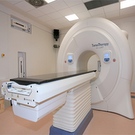Targeted Irradiation And Stem Cell Transplantation Show Promise In Phase 1 Clinical Trial For Multiple Myeloma

The results of a Phase 1 clinical trial in multiple myeloma patients indicate that total body irradiation using a technique that focuses radiation on the bone marrow is a safe and effective way to prepare the bone marrow for stem cell transplantation. By focusing the radiation on the bone marrow, the researchers were able to limit damage to organs in the body and reduce resulting side effects.
Total body irradiation is commonly used prior to stem cell transplantation to destroy cancerous cells in the bone marrow. The bone marrow is then repopulated with healthy transplanted cells.
A technique known as helical tomotherapy is an image-guided procedure that allows physicians to concentrate the radiation on affected areas, protecting surrounding organs.
When undergoing helical tomotherapy, patients lie on a table that is moved through a donut-shaped machine. Radiation sources then move around the patient in a spiral, or helical, pattern. This allows for delivery of radiation to the cancer source from many different directions.
The goal of this study, conducted by researchers at City of Hope Cancer Center, was to determine the safety and efficacy of total marrow irradiation delivered by helical tomotherapy in multiple myeloma patients undergoing stem cell transplantation.
A total of 22 myeloma patients enrolled in the study and underwent tandem stem cell transplantation. In a tandem stem cell transplant procedure, a patient undergoes two consecutive transplantations. The second transplant is performed once the patient has recovered from the first stem cell transplant.
Patients received high-dose melphalan (Alkeran) to prepare their bone marrows for the first transplant. An average of 63.5 days following melphalan administration, patients underwent irradiation using helical tomotherapy in preparation for their second transplant.
Different doses of radiation were administered to subsets of patients in order to determine the safest dose.
Thirty days after irradiation, 23 percent of patients achieved a complete response and an additional 50 percent had a very good partial response.
Maximum responses were typically seen around 10 months after transplantation, while patients were on maintenance therapy with dexamethasone (Decadron) and thalidomide (Thalomid). Response rates increased to 55 percent of patients achieving a complete response and 27 percent achieving a very good partial response.
After 35 months of follow-up, progression-free survival was 53 percent, and overall survival was 84 percent.
At the highest radiation dose of 1800 cGy, patients experienced severe side effects, such as congestive heart failure, abnormally low blood pressure, and inflammation of the lungs and small intestine. The maximum-tolerated radiation dose was therefore 1600 cGy.
The estimated radiation dose to normal organs ranged from 11 percent to 81 percent of the full dose administered to the bone marrow. The radiation exposure to normal organs increased with higher doses, but remained below what would have been expected for the same dose administered during standard full body irradiation.
Researchers noted that, in general, the side effects of total marrow irradiation given by helical tomotherapy were similar to those seen following high-dose melphalan therapy.
For more information, please see the research article in Clinical Cancer Research (abstract).
Related Articles:
- None Found

Do you know if they collected stem cells prior to the radiation?
Hi Lori,
Patients' stem cells were collected prior to the melphalan treatment and first transplant. Half of the stem cells were then used for the first transplant, and half were used for the second transplant.
Progress toward fundraising goal
for all of 2020:
15%
For more information, see the Beacon's
"2020 Fundraising: Goals And Updates" page